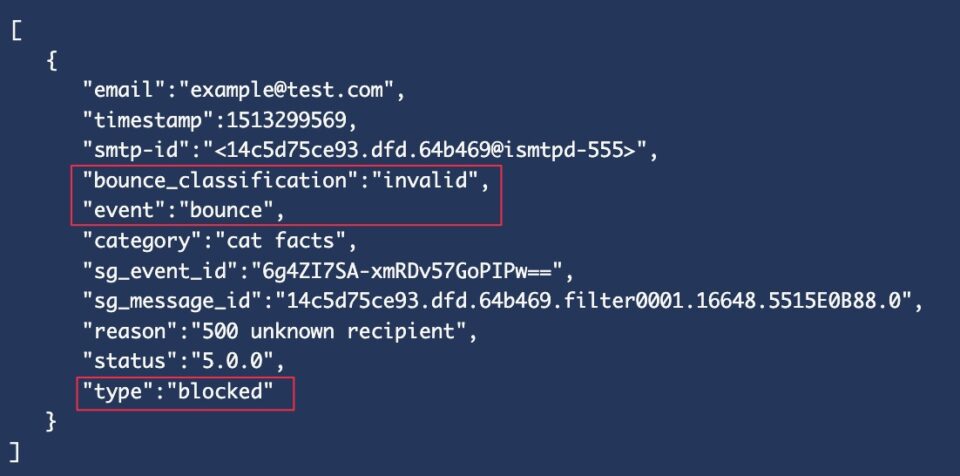Send With Confidence
Partner with the email service trusted by developers and marketers for time-savings, scalability, and delivery expertise.


Time to read: 5 minutes
If you’ve ever had a customer-facing email blocked by a server, you know how stressful it can be—especially when you’re not sure why the email didn’t make it to the recipient’s inbox.
Low engagement rates on your emails can adversely impact your sending reputation, so email marketers must collect data on metrics like open rates and spam complaints. With these insights into your email delivery, you can improve and maintain your sending reputation and answer questions like:
Twilio SendGrid has identified measurable, meaningful—and often overlooked—email events that can happen regardless of your sending reputation. These four events may occur between the time you send your email and when it reaches the receiving server:
Let’s take a closer look at each of these events to help you understand your email delivery performance better.
There’s a common misconception that delivered messages always make it to the recipient’s inbox. The truth is that when a message registers as delivered, it only means the receiving server has accepted the message—but it must still decide what to do with it.
Usually, the server’s options are to deliver the message to the intended inbox or redirect it to the recipient’s spam or junk folder. But in rare cases, a receiving server might instead choose to drop that message—meaning, delete it. When this happens, the recipient won’t be able to find the message anywhere—even in their spam folder.
The server decides where to put the message based on signals like the sender’s reputation and the email content. Senders that have excessive spam complaints or send content that inbox providers know generates high spam complaint rates are less likely to have their emails delivered.
However, having a high percentage of delivered emails is only one part of your campaign’s success story. Next, your emails need to make it to the recipient’s inbox.
If you’ve never had blocked emails, you might wonder, “Do blocked emails bounce back to the sender?”
While some in the email industry use terms like hard bounce and soft bounce to describe messages refused by the receiving server, SendGrid’s terminology separates returned messages into two categories: bounces and blocks.
Bounces occur when the receiving server returns a code indicating that there’s a permanent issue with that server or the recipient’s address. The most common reason for an email address bounce is that the address in question is invalid.
If you use Twilio SendGrid’s Event Webhook to digest your email events, you’ll see bounces identified by the bounce event under the bounce type.
Here’s an example of a bounced email: Now that you understand email bounces, it’s time to answer the question, “Will emails bounce back if blocked?” The answer is yes—all emails sent to a invalid address bounce back to the sender.
Now that you understand email bounces, it’s time to answer the question, “Will emails bounce back if blocked?” The answer is yes—all emails sent to a invalid address bounce back to the sender.
Blocked emails are similar to soft bounce emails. For these temporary rejections, the receiving server’s reason for refusing the message is unrelated to the sender’s address quality.
In SendGrid’s Event Webhook, blocks are identified by the bounce event under the blocked type.
Here’s an example of a blocked email message:  Reasons for a blocked email message include:
Reasons for a blocked email message include:
High spam complaint rates can lead servers to filter more emails from a particular sender to the spam folder and can result in email blocks. If you see many blocked messages, this can indicate damage to your sending reputation.
A deferred event, or deferral, occurs when the server temporarily limits access to its system. It works much like a telephone’s busy signal.
But this doesn’t mean that your message won’t get delivered—only that it won’t get delivered immediately. Some of the most common reasons for a message deferral include:
Here is a deferred email example:  When an inbox provider defers your email, SendGrid will still attempt to deliver your message for up to 72 hours. If your message gets deferred for more than 72 hours, it will get blocked and a block event will register. However, if the message gets successfully delivered within the 72-hour window, it’ll register as a delivered event.
When an inbox provider defers your email, SendGrid will still attempt to deliver your message for up to 72 hours. If your message gets deferred for more than 72 hours, it will get blocked and a block event will register. However, if the message gets successfully delivered within the 72-hour window, it’ll register as a delivered event.
Follow the steps in SendGrid’s email delivery troubleshooting guide if you experience lengthy or frequent deferrals on your email campaigns.
Tracking email delivery events provides insight into what happens with your emails while journeying to the recipient’s inbox. This helps you craft sharper and more strategic email campaigns while reducing customer-facing emails blocked by servers.
Want to dig deeper into the health of your email campaigns? We can help. Twilio SendGrid’s 2023 Email Deliverability Guide features the latest industry trends, email news, and delivery best practices.
Plus, if you want an email provider to help you improve your deliverability, explore the top email marketing services to find the right provider for your business.
And if your business uses SendGrid’s Event Webhook to digest your existing email data, our documentation can help you understand delivered, blocked, bounced, and deferred emails.
Ready to move beyond “email blocked by server” errors to consistently deliver your emails to customer inboxes instead? Sign up for a SendGrid account today to get started for free.
Partner with the email service trusted by developers and marketers for time-savings, scalability, and delivery expertise.